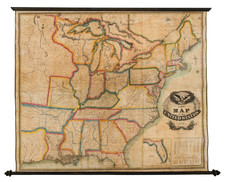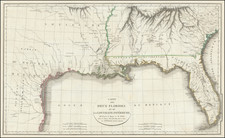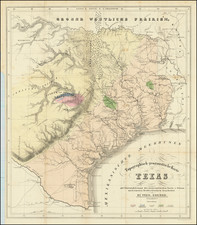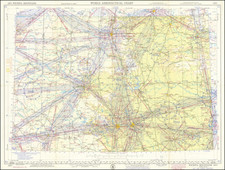Map and Survey Resolving A Boundary Dispute on the Trinity River Between Phillip Sublett and Thomas McKinney.
Survey map signed by E. Jewell, acting Deputy Surveyor for Liberty County, in the Republic of Texas,"in the Surveyor's District Including Menard's Creek and Its Vicinity," the location of the area surveyed.
Jewell certifies that he has been employed to examine two surveys original surveys, including: Peter J. Manard (likely Pierre J. Menard), P. A. Sublett (Phillip A. Sublett) and McKinney's Mill Tract, 6 Leagues (Thomas F. McKinney). The purpose of the Survey was to resolve a conflict in two prior surveys which defined the Sublett and McKinney lands, described by Jewell as:
- A League Survey by Captain Hirams For Phillip A. Sublett
- The Six Leagues Mill Tract
The original 1831 surveys were apparently determined to be in conflict, requiring Jewell's examination. Jewell notes:
And I find that the Lines of the Six Leagues Mill Tract Enter the P. A. Sublett League on the South boundary Line, and crosses it at Right angles Sixteen Hundred and Forty 1640 Varas East of the South West Corner of Said Sublett's League . . .
A True platt of the Sublett League, and Interference I have made out and as shown above proportioned according to distance Made out by Captain Hirams, on the Survey of Subletts, and according to the course and distance of the Interference Lines of the Six Leagues Tract Run by Myself.
By an Examination of the Field notes of the Six Leagues Mill Tract, Furnished me by commissioner [John Pettit] Borden of the General Land Office, I find that they are dated teh 25th April 1831, and was Surveyed for Thomas F. McKinney.
Given by me the 3rd day of August in the year 1840.
E Jewell D.S.
Phillip Allen Sublett
Philip Allen Sublett (1802-1850) was born in Green County, Kentucky and immigrated to Durango, Mexico, in 1824. On May 31, 1828, he was granted Texas citizenship and settled three miles east of San Augustine. He was married to Esther (Easter, Hester) Jane Roberts, the daughter of Elisha Roberts. Sublett participated in the battle of Nacogdoches in 1832 and was chosen as the delegate from Ayish Bayou-the San Augustine community-to the conventions of 1832 and 1833.
On November 1, 1834, Sublett was elected second judge of the San Augustine municipality. In 1835, Sublett was elected chairman of the San Augustine Committee of Safety and Correspondence.
Sublett was commissioned lieutenant colonel October 23, 1835. He was later named assistant adjutant general of the army. He served until December 14, 1835, and was present at the siege of Bexar, December 5-10, 1835.
On December 18, pleading the press of "private affairs," he declined the command of the First Regiment, Texas Volunteers, in favor of Edward Burleson. He thereupon returned to his farm, where on March 21, he was appointed to a committee to go to Fort Jessup, Louisiana, to inform the commandant of the perceived threat to Nacogdoches and San Augustine by hostile Indians thought to be gathering on the Trinity River.
Houston resided in Sublett's home in July 1836, after being treated for a wound received during the battle of San Jacinto. On September 1, Sublett was appointed one of three commissioners to enroll a company of San Augustine militia in which he served as a private under Capt. D. Brown.
Sublett was a developer of the town of Sabine, now Sabine Pass, at the mouth of the Sabine River. By 1840, he owned 1,400 acres of land, two town lots in San Augustine, and 123 in Sabine, twenty slaves, fifty cattle, three horses, and a gold watch.
Thomas F. McKinney
Thomas Freeman McKinney (1801-1873) was born in Lincoln County, Kentucky. By 1822 the McKinneys and their kin, the McLeans and Subletts, moved first to southern Illinois and then Randolph County, Missouri, where the men engaged in farming, hunting, and the fur trade. McKinney went to Santa Fe in 1823 and then Chihuahua, Durango, Saltillo, and Bexar.
In 1824, McKinney received a league on the Brazos River from Stephen F. Austin, but a trip to Ayish Bayou, where his uncle Stephen Prather had a trading post, convinced him that the Nacogdoches area was best for trade. He married Nancy Watts in 1827, and kept a store on the square in Nacogdoches until 1830. In 1830, he moved to San Felipe and continued trading to the south, sometimes in partnership with the sons of Jared E. Groce. He also maintained an interest on the lower Trinity, where Michael B. Menard developed a sawmill.
In 1834, he became senior partner with Samuel May Williams, in McKinney and Williams, a firm located on the Brazos, which supplied the bookkeeping and commercial contacts in the United States, while McKinney collected and shipped the cotton. The firm developed Quintana at the mouth of the River in 1835 and used its credit to help finance the Texas Revolution to the amount of $99,000.
McKinney, on board his schooner, San Felipe, captured the Correo de Mexico in September 1835. The Mexican vessel had been preying on Texas-bound shipping. McKinney obtained a privateering licence from the Provisional Government and used the firm's credit to buy the William Robbins, renamed Liberty, for the rebel government. Though he refused commissions as commissary general and loan agent, he continued to forward men and supplies to the Texas army.
He and Williams joined Menard in 1833 in a scheme to claim Galveston Island. In 1836, they combined with others to secure a charter for the Galveston City Company. The firm had a wharf and warehouse on the island in October 1837, when Racer's Hurricane struck and severely damaged their property.
McKinney withdrew from the partnership with Williams in 1842 and devoted himself to trading and stock raising, first on the island, where he had a race course, and in 1850 in Travis County, where he constructed a fine stone house, a gristmill, and another quarter horse track opposite the capital city.
McKinney served as state senator from Galveston in 1846, and as representative in 1849. He was a member of the Democratic party and a Unionist in 1860-61. He had opposed independence, annexation, and secession, but once each was accomplished, he worked to support the government. During the war, he suffered financial reversals from which he never recovered financially.
Menard's Saw Mill
Michel Branamour Menard was an Indian trader, entrepreneur, and founder of the Galveston City Company, who was born on December 5, 1805, at La Prairie, near Montreal, Quebec. He began work with the American Fur Company at Detroit about 1820 and worked in the Minnesota area for two years. In 1822, he joined his uncle, Pierre Menard, former lieutenant governor of Illinois, in the fur trade at Kaskaskia. While working for Menard, he became a resident trader to a band of Shawnees living near Ste. Genevieve, Missouri. He was chosen a chief and moved with the tribe to the White River in Arkansas Territory and later, in 1828, to the Red River below Pecan Point, on the Trinit River.
On December 1, 1829, Menard applied for citizenship in Nacogdoches, where he continued to collect skins and furs from the Shawnees and other Indians. He also began trading at Saltillo, Coahuila, exchanging horses, mules, and permits to locate Texas land for manufactured goods. By 1834, Menard owned 40,000 acres scattered from the lower Trinity River above Liberty to Pecan Point. He built a combination sawmill and gristmill on Menard Creek in 1833, which he operated with the aid of his cousin, Pierre J. Menard, and other relatives who moved to Texas. He continued to send forest products to Menard and Vallé and the American Fur Company until 1836.











![[ Republic of Texas ] A Map Of The Republic Of Texas And The Adjacent Territories, Indicating The Grants of Land Conceded Under the Empressario System of Mexico](https://storage.googleapis.com/raremaps/img/small/85444.jpg)

![[Matagorda Bay: Pictorial Letter Sheet]](https://storage.googleapis.com/raremaps/img/small/40810.jpg)
